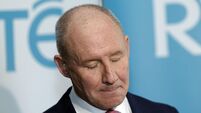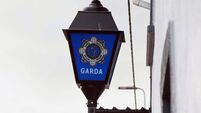Positivity rate at record high but vaccines keeping hospital numbers down

A queue at the Covid test centre at Cork Airport business park this week. The HSE reported little to no waiting at vaccination centres across the country yesterday. Photo: Eddie O'Hare
The proportion of people being tested who are positive for Covid-19 is the highest it has been so far in the pandemic, amid a warning that Ireland is still at the early stages of the “rampant” Omicron surge.
However, the “wall of protection” built up by vaccination, boosters and prior infection is helping to prevent the high levels of hospitalisation seen in other waves, according to immunology professor Paul Moynagh.
A further 9,006 cases were reported yesterday, while 521 people are currently in hospital with Covid-19. This figure has risen by 143 since Christmas Day [Saturday], and rose by 59 from Monday.
The testing system remains under severe strain with not a single PCR testing slot available online throughout the country yesterday. On Tuesday, 24,940 tests were completed, according to the Covid dashboard.
The positivity rate over the last seven days is the highest it’s been at any stage of the pandemic so far, at 30.5%. This means that almost one in every three PCR tests conducted returns a positive result.
In the first wave of Covid-19 in March 2020 and during the surge in January 2021, the seven-day positivity rate did not rise above 25%.
Professor Moynagh, from Maynooth University, said that the levels of transmission are “really, really high” at present due to how well Omicron transmits from person to person, adding that the numbers reported may be a fraction of the full picture.
However, Professor Moynagh said the currently increasing hospital figures do not mirror the far higher numbers seen at the same time last year, and that boosters for those in very vulnerable groups are proving “really important” in helping to protect them from serious illness.
Read More
“While we’re seeing really large numbers, they’re not translating into the hospitalisation we’ve seen before,” Professor Moynagh said. However, he added that the high case numbers still had the potential to put the health system under “significant strain”.
HSE chief executive Paul Reid, meanwhile, said yesterday that Omicron is “rampant” and “running rife” in the community.
He told RTÉ’s Morning Ireland that the sheer volume of cases was overwhelming the PCR testing service, and that if someone thought they had Covid, they likely did have it. He warned that Ireland is still at the early stages of the curve of Omicron.
Separately, people aged 30 to 39 are officially eligible for the booster from today, although many of those in this age group have already received it. Boosters are available at walk-in clinics, at participating pharmacies or GPs, or by booking a time slot for a centre online.
The HSE reported little to no waiting at vaccination centres across the country yesterday as people aged 40 and over were eligible to receive their booster.





